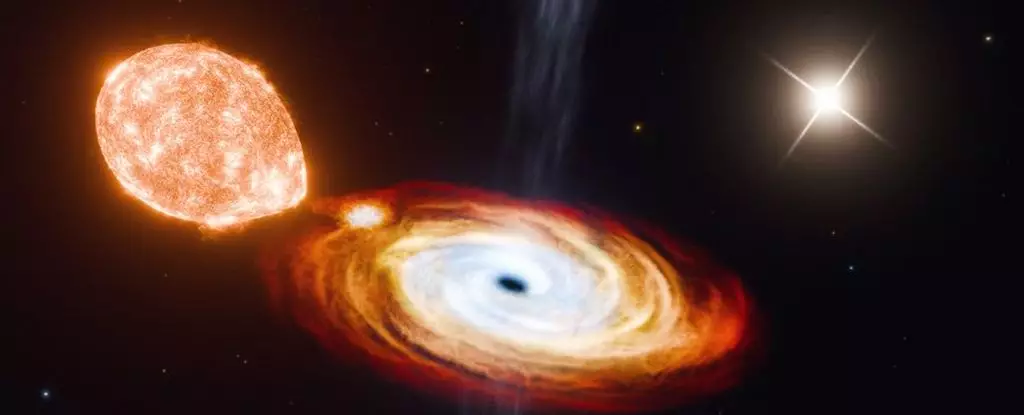In the vastness of the universe, the constellation of Cygnus houses a remarkable phenomenon that is captivating astronomers worldwide: the V404 Cygni system. Located about 7,800 light-years from Earth, this system features a black hole that has gained notoriety not just for its presence, but for its unusual interactions with two stars. Recent observations have unveiled a surprising trinary configuration that challenges existing theories on black hole formation, sparking renewed interest in understanding these enigmatic celestial bodies.
V404 Cygni initially fascinated scientists with the discovery of a black hole that orbits a companion star every 6.5 days. In addition to this primary pair, the revelation of a third companion star, which orbits the black hole on a much larger scale—taking around 70,000 years to complete a full loop—has added a fresh layer of complexity to the system. This newfound trinary structure is unprecedented and may provide invaluable insights into the mechanisms that lead to black hole formation.
Kevin Burdge, a physicist at the Massachusetts Institute of Technology, highlights the gravity of this discovery: “This system is super exciting for black hole evolution, and it also raises questions of whether there are more triples out there.” The finding contests the conventional view of black hole creation, which predominantly involves violent supernova explosions. Before this, astronomers had presumed that the companion star was merely a close neighbor of the black hole, contributing little to a deeper understanding of its genesis.
The European Space Agency’s Gaia mission, a groundbreaking endeavor aimed at mapping the Milky Way, played a crucial role in this revelation. Gaia has meticulously recorded the three-dimensional positions, velocities, and trajectories of various celestial objects, including V404 Cygni and the newly discovered companion star. The data indicated that these two stars were not merely coexisting in the vastness of space by chance; they were moving together through the cosmos at similar velocities, suggesting a gravitational relationship.
Burdge asserts, “It’s almost certainly not a coincidence or accident,” emphasizing that the gravitational connection between these stars suggests a deeper cosmic relationship. Their movement through space as a cohesive unit supports the classification of V404 Cygni as a trinary system—a significant leap in understanding the formation and evolution of black holes.
Historically, the formation of stellar-mass black holes has been largely attributed to supernova events, where an aging star dramatically erupts and collapses, leading to the creation of a black hole. Yet the discovery of V404 Cygni’s trinary system casts doubt on this theory. Burdge and his colleagues propose that for the wide orbital separation observed in this new relationship to exist, a supernova explosion would likely have disturbed the delicate gravitational tether between the black hole and the distant star.
Instead, simulations conducted by the team favor an alternative model known as direct collapse, where the massive star implodes into a black hole without the chaotic aftermath of a supernova. This model not only provides clarity as to how V404 Cygni maintains such a unique configuration but also implies that this method of formation could be more common than previously thought. Burdge notes, “The vast majority of simulations show that the easiest way to make this triple work is through direct collapse.”
The implications of this discovery are profound. Not only does it provide the first strong evidence supporting the direct collapse model, but it also raises the possibility that additional trinary black hole systems may be lurking within our galaxy, overlooked due to black holes’ elusive nature. Kareem El-Badry, an astronomer at Caltech, points out the significance of this finding, asserting that if such systems are indeed common, they could offer solutions to long-standing questions surrounding the formation of black hole binaries.
The emergence of trinary systems like V404 Cygni suggests that the evolution of black holes may involve pathways that are not available to simpler binary systems. This enriches our understanding of cosmic evolution, opening up new avenues for research and exploration.
The V404 Cygni system serves as a prime example of how astronomical discoveries can challenge and refine our understanding of the universe. As research continues, the mysteries of black hole formation may become clearer, potentially reshaping the landscape of astrophysics. The ongoing curiosity surrounding these celestial giants emphasizes the importance of continued exploration, pointing to a future filled with potential discoveries that lie beyond our current knowledge.


Leave a Reply